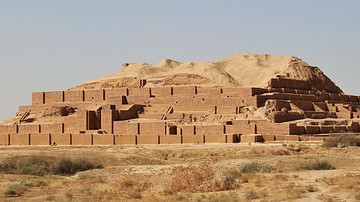Godin Tepe is, today, an archaeological site in the Kangavar valley of Luristan, in western central Iran. The name means "hill of Godin" though what the settlement was called originally is unknown. The site was first discovered in 1961 during an archaeological survey conducted by the Museum of the University of Pennsylvania and excavation of the mound began in 1965 resulting in important finds throughout the next three decades (with various interruptions due to conflict in the region) catalogued by assorted teams from many different countries.
A great deal of controversy surrounds the excavations done by T. Cuyler Young, jr (who was in charge of excavations at the site 1965-1973) for his decision to make a deep sounding of the hill which allegedly resulted in the destruction of part of the Median palace from Period II. The artifacts recovered from the site, however, which tell the story of the early nomads from beyond the Zagros Mountains who settled in Mesopotamia, are extremely important and would never have been found without the efforts of Young and those like him.
A Sumerian Trade Centre
The site was a Sumerian settlement first inhabited c. 5000 BCE which comprised a village and a fortress. It became an important stop along the Great Khorasan Road trade route, better known as the Silk Road, which was the major avenue for trade for close to 3000 years (the designation "silk road" was first coined in 1877 by the German geographer Baron Ferdinand von Richthofen in reference to the trade of Chinese silk). As the Khorasan Road was not the only one used in trade, and silk was not the only commodity traded, many modern scholars prefer "silk routes" as the name for trade routes, with Khorasan Road being only one of many.
Eleven very distinct cultural phases have been identified at the site and it was continually occupied until c. 1600 BCE when it was abandoned after an earthquake destroyed much of the settlement. When the area was finally reoccupied some 800 years later, the new structures were built on the soil which covered the old, as was often the practice throughout Mesopotamia's history.
Periods V to I
In the excavation level known as Period V (3500-3100 BCE) late materials from the city of Uruk have been discovered such as writing tablets, pottery, bevel-rimmed bowls, statues of deities and cylinder seals. This period corresponds to what is known as the late Uruk period and, during this time, trade flourished. Both beer and wine were brewed at Godin Tepe, as evidenced by finds in clay jars, dating to this period. The means of producing both beer and wine seem to have been discovered concurrently c. 3500-3100 BCE but which came first remains unclear. There is controversy among modern scholars whether beer or wine was first produced at Godin Tepe but the preponderance of evidence favors beer. It would seem that the brewing of beer developed among bakers (who were initially women, as were the later brewers, Inn-keepers, and bartenders) who first recognized the possible benefits of fermentation. Beer was the most popular drink throughout Mesopotamia for centuries, with wine a close second, and so it is likely the debate will continue until conclusive evidence is found which settles the controversy.
Period IV dates from 3000-2650 BCE and excavations revealed more elaborate houses, evidence of metal working and advances in architecture in open-air buildings and enclosures. Sometime around 2400 BCE the settlement was invaded and partially destroyed as arrow-pierced skeletons and collapsed walls from this time indicate. The area seems to have been abandoned, at least temporarily, after this attack.
Period III (2600 - 1600 BCE) saw centralization of industry, a dense population, and booming trade. During this period Godin Tepe was a thriving town and the largest settlement in the area. Advances in trade, commerce, metal working and other areas were made and the town could afford luxuries as evidenced by ceramics and large, commercial butcher shops. Thanks to the great influx of wealth from trade with the city of Susa, and other settlements in the Luristan valley, Godin Tepe grew steadily. It is thought to have been a part of the Elamite confederacy until destroyed by the earthquake and abandoned.
The site was left uninhabited until Period II (750-500 BCE) when it was a fortified town of the Medes. Under the Medes a great palace was built on what was now a high hill covering the original settlement. The palace had three grand colonnaded halls, a throne room and an audience chamber for the king to receive guests and supplicants. There was also a section of the palace devoted to living quarters and a kitchen and dining area. Evidence of a drainage system has also been found in this part of the building. The architecture of the palace and ceramics discovered from this period show close ties to Pasargadae, the city of Cyrus the Great and capital of the Achaemenid Empire. The palace is the only substantial structure from Period II and was abandoned sometime before 500 BCE when it was left open for use by squatters and travelers.
By Period I (mid-1400 CE) the site had been buried by the sands and a Muslim shrine was built on the mound near to an old cemetery. Today the area is still being excavated by archaeologists with parts of it open to the public as a historic site.





